Bidhannagar/Kolkata: Ujjwal Biswas, 52, braced himself as he emerged from his well-kept two-storey house in West Bengal’s Bidhannagar. As he rushed to buy fish, the private company executive carefully dodged the stagnant blood-stained water spilling over from a blocked drain at Baisakhi market. An open bin for the shopkeepers to dump their daily waste overflowed on the other side of the road, with dogs feasting on leftover carcasses. Passersby quickly covered their noses with their hands or looked away while crossing the filthy mess. “This is an everyday ordeal, but we don’t see it changing,” Biswas shrugged.
This is the reality in many parts of Bidhannagar, also known as Salt Lake City, a Kolkata suburb in the 24 North Parganas district. Despite aspirations to be one of the state’s most developed townships and boasting its IT hub, Electronic City, it now holds the dubious distinction of being listed among India’s top 10 dirtiest cities, according to the 2023 Swachh Survekshan survey conducted by the central government. In fact, the survey’s ten dirtiest cities are all in West Bengal, including Kolkata.
But residents are conflicted. They acknowledge that sanitation and cleanliness need improvement, but also contend that the entire township should not be painted with the same dirty brush.
“We are so used to dirt and filth in public spaces that it hardly makes a difference now. We don’t see citizens protesting, we don’t see politicians ensuring proper funds are allocated for waste management. The casual attitude from all quarters has led to this poor condition in pockets of the city,” said Shantanu Mitra, a resident of Bidhannagar. But he added a caveat: “Overall, I would still say, the area is much cleaner than other cities or even Kolkata.”
You can’t get results if you don’t sit for the exams, so these rankings are not correct
-Senior West Bengal government official
Planned as an upscale township, Bidhannagar is divided into 41 wards, each with its own market. The roads are well-kept, the parks are tidy, and even the pay-and-use public toilets are frequently cleaned by dedicated attendants. Yet, a polluted canal and the surrounding market areas are hotbeds of filth and mosquitoes.
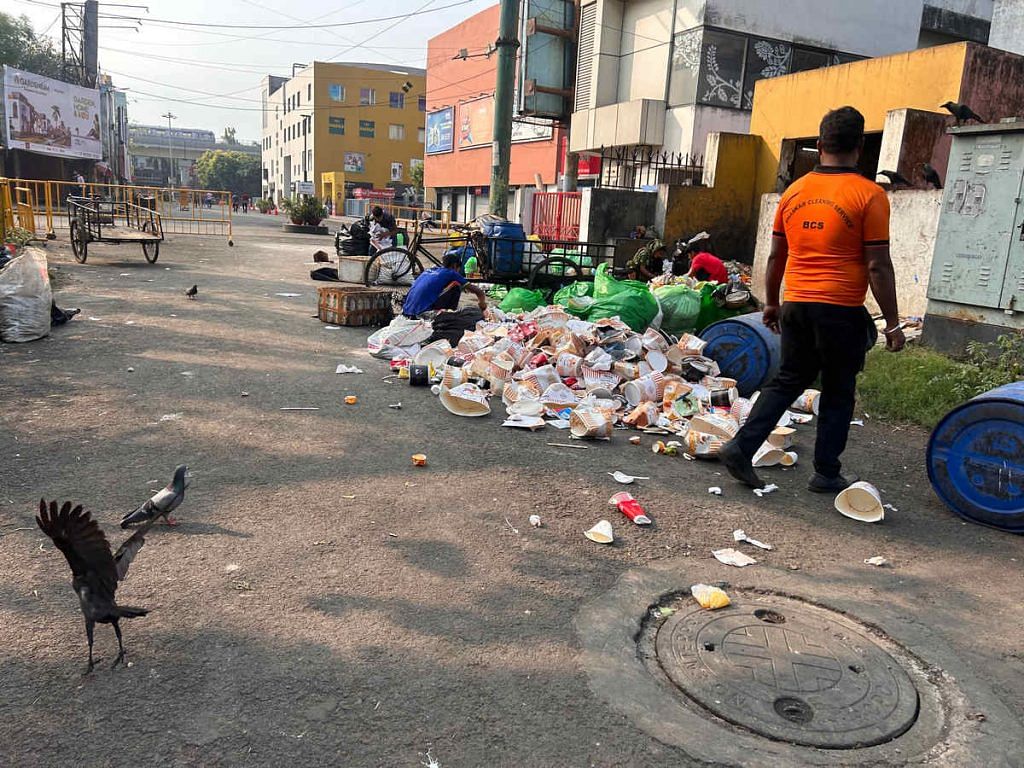
Even City Centre, the longest-standing mall in the area, isn’t immune. A designated dumping ground lurks nearby, a constant reminder of Bidhannagar’s struggle against waste. Although municipal waste trucks rumble in regularly to collect the refuse, the overpowering stench from the open pit creates a nauseating contrast to the curated shopping experience within.
However, state officials claim that the ‘dirtiest’ ranking bestowed on Bidhannagar and other West Bengal cities is spurious since the state didn’t participate in the survey. For many, the ranking reflects dirty politics more than cleanliness issues.
All ten of the dirtiest cities with populations exceeding 100,000 are in West Bengal—Howrah, Kolkata, Bhatpara, Bidhannagar, Rishra, Kalyani, Madhyamgram, Asansol, Kanchrapara, and Sreerampore.
Also Read: Surat’s Swachh sweep—how diamond city went from plague to podium in 30 years
Crying foul over politics
The Mamata Banerjee-led Trinamool Congress government has been cold-shouldering the Swachh survey ever since 2017—the year after its debut as the cleanliness litmus test for Indian cities. These defiant “boycotts” have not gone unnoticed, even drawing a sharp rebuke from Union Housing and Urban Affairs Minister Hardeep Singh Puri, under whose ministry the survey is carried out.
“When cities of West Bengal didn’t do well in Swachh Survekshan 2016; instead of taking steps to improve the sanitation infrastructure in the state, Mamata Banerjee refused to participate in all subsequent world’s largest cleanliness surveys,” he tweeted in 2021.
However, skipping the survey hasn’t shielded West Bengal’s cities from occasionally appearing on the “dirtiest cities” list. For example, in 2018, despite the state government’s shunning of the survey, 19 out of the 25 dirtiest cities were in West Bengal.
The TMC government consistently criticises initiatives undertaken by the Narendra Modi government. It comes as no surprise that the state doesn’t take part in such surveys. The TMC chooses politics over welfare
– Samik Bhattacharya, West Bengal BJP spokesperson and MP
In the latest rankings, too, Bengal has made a clean sweep at the bottom. All ten of the dirtiest cities with populations exceeding 100,000 are in West Bengal. Howrah has been judged the dirtiest, followed by Kalyani, Madhyagram, Krishnanagar, Asansol, Rishra, Bidhannagar, Kanchrapara, Kolkata, and Bhatpara. Among them, Kolkata, Bidhannagar, and Howrah are major urban centres, while the rest are situated in semi-urban areas, all within districts adjacent to Kolkata.
This result has triggered accusations of bias in West Bengal, given the ongoing tension between Mamata Banerjee and the central government. It doesn’t help that many top performers in the cleanliness rankings, like Surat and Indore, are in BJP-ruled states.
Kolkata Mayor and state minister of municipal Affairs, Firhad Hakim, wasted no time in refuting the results soon after they were announced. He claimed the rankings were intended to “malign the image” of West Bengal and promote “private agencies” in waste management. Meanwhile, residents across West Bengal, from Kolkata to Kalyani, took to social media. Some criticised the TMC for not prioritising cleanliness, while others railed against the perceived injustice.
This is Kalyani (West Bengal)
The city which the Godi media has called as the 2nd Dirtiest in India. pic.twitter.com/BwC5gNFHNv
— Nabarun Bhattacharya (@Nabarun204) January 13, 2024
Public health and civic officials have also highlighted various ‘inaccuracies’ in the rankings. For instance, Kolkata received a zero score in waste processing despite operating a 500-metric-tonne plant that converts biodegradable waste into manure. Similarly, the city’s score of zero for cleanliness of public toilets has been questioned.
Meanwhile, Union government officials associated with the survey have denied any “malice” in the rankings. And West Bengal BJP spokesperson and MP Samik Bhattacharya told ThePrint that it’s the Trinamool Congress that’s playing politics.
“The TMC government consistently criticises such initiatives undertaken by the Narendra Modi government,” he said. “It comes as no surprise that the state doesn’t take part in such surveys. The TMC chooses politics over welfare.”
The 2023 Swachh Survekshan was conducted across 4,447 urban local bodies in India, with the results based on over 12 crore citizen responses. It assesses cities on various parameters, including municipal solid waste collection and transportation, street sweeping, and public toilet facilities. The survey aims to foster “healthy competition” through its rankings.
The survey report states that West Bengal and Manipur had “partially participated” in the survey. A senior state government official, speaking on condition of anonymity, said that this might be due to individual local bodies participating. “When the state administration doesn’t provide data or information, NGOs usually help, but I have no knowledge how the rankings were reached,” he said.
The official position is that West Bengal was never in the running at all and therefore the rankings for it don’t stand. “You can’t get results if you don’t sit for the exams, so these rankings are not correct,” the senior official said.
In the Swachh Survekshan survey, Kolkata was adjudged the ninth-dirtiest city in India, with the top spot taken by its sister city Howrah. Bidhannagar was ranked seventh in this list.
‘Waste Bengal’
West Bengal has long struggled with garbage control, earning the unflattering nickname “Waste Bengal” from some critics. In 2022, the National Green Tribunal fined the state government Rs 3,500 crore for failing to manage solid and liquid waste. Out of the 13,469 tonnes of solid waste generated in the state per day at the time, nearly 80 per cent reportedly remained unprocessed.
Kolkata and its satellite cities, in particular, have got a bad rap. In 2020, the Calcutta High Court took suo motu action, filing a Public Interest Litigation (PIL) to protect the city’s green spaces from pollution, especially the Maidan, a popular tourist attraction. The court established a committee to oversee the upkeep of this green lung and directed authorities to maintain a litter-free environment.
In the Swachh Survekshan survey, Kolkata was adjudged the ninth-dirtiest city in India, with the top spot taken by its sister city Howrah. Bidhannagar was ranked seventh in this list.
However, officials in all three places have highlighted the strides they have been making in waste management.
In Kolkata, the official quoted earlier claimed 96 per cent of the city is covered under waste collection services. The Kolkata Municipal Corporation (KMC), according to him, has been segregating waste with the help of technology, while employing different mechanisms to process bio-waste. “We continuously monitor waste collection and disposal,” he said.
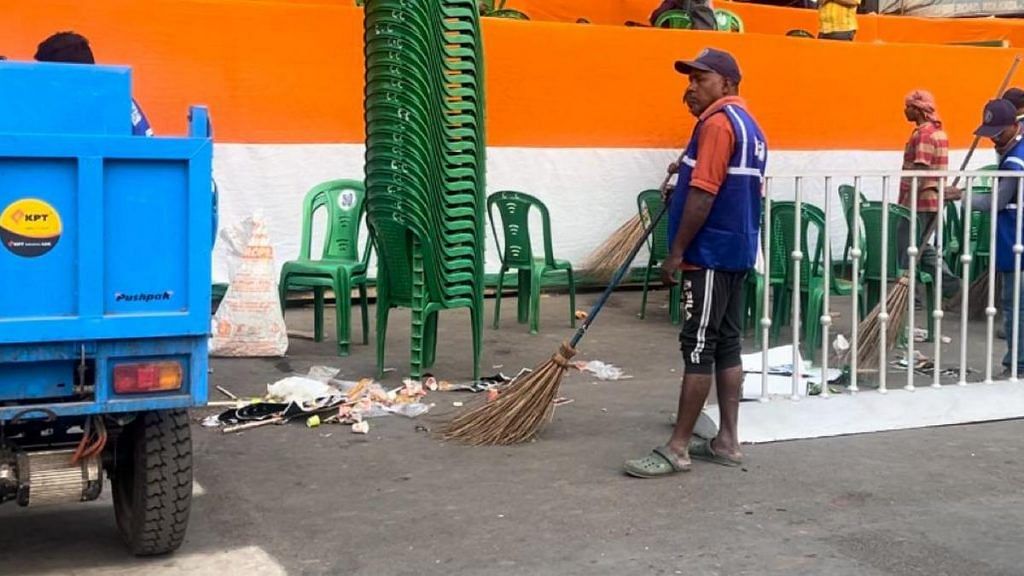
In Howrah, too, officials have protested that they don’t deserve their ranking, citing factors like the ongoing waste treatment plant project at the infamous Belgachia dump site. Last May, minister Hakim also launched a bio-mining project to reclaim land and process the estimated 10 lakh tonnes of legacy waste at this site. The Kolkata Metropolitan Development Authority (KMDA) is collaborating with the Howrah Municipal Corporation (HMC) to clean up the entire area within the next three years.
Similarly, Bidhannagar Municipality Corporation (BMC) claims to be one of the state’s first civic bodies in the state to introduce separate bins for biodegradable and non-biodegradable waste. This trash is collected door-to-door every morning, segregated partially by hand, and then dumped in closed vats for processing.
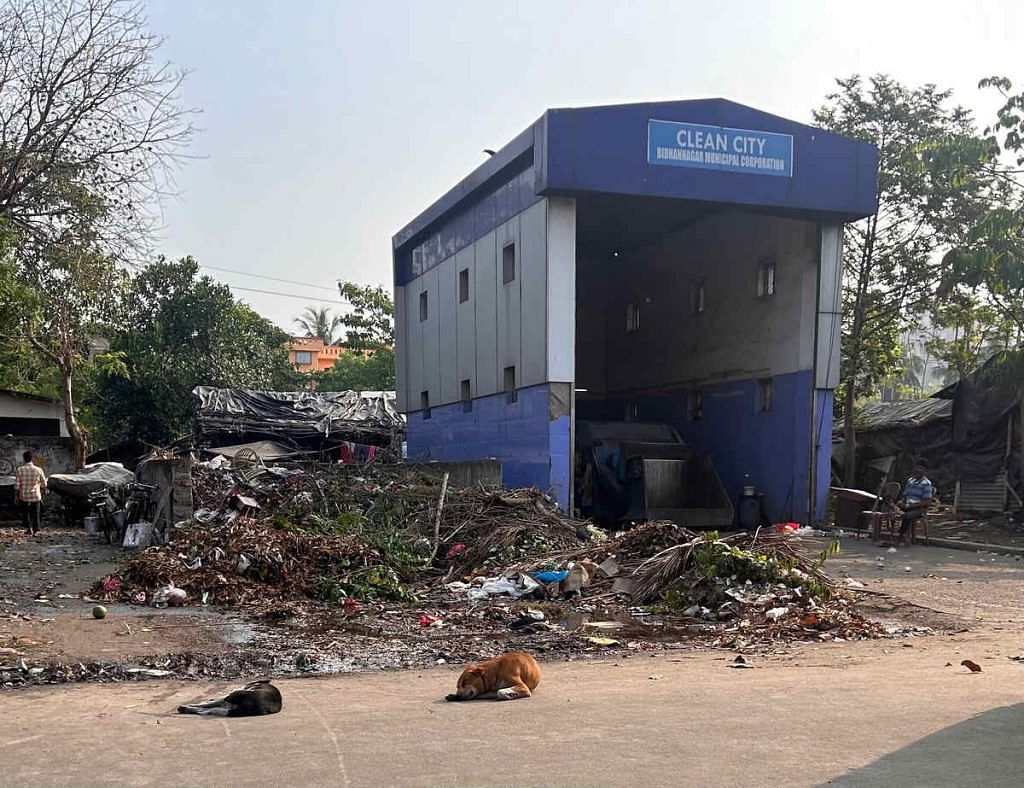
According to the Swachh Sarvekshan report, Bidhannagar fared well in the upkeep of public toilets and citizen feedback, though the report doesn’t mention how many people were surveyed.
Bidhannagar resident Sujoy Das, while shopping for vegetables at the local market, claimed there have been significant improvements in waste management over the years. “Earlier, during the CPIM government, the state of markets used to be deplorable,” he said. Now the markets are cleaner, waste is dumped in one big garbage collector, but there is always scope for improvement and citizens play a big role.”
Also Read: Mumbai’s deep clean drive has left some dusty corners. Girgaon is one story, Govandi another
Dichotomous cities
Kolkata might boast a cosmopolitan vibe, but a wrong turn can reveal a different story. Areas near important landmarks like Red Road, Bhawanipore, High Court, Raj Bhavan, Eden Gardens, and Victoria Memorial are swept every day and kept spotless even with heavy tourist footfall. But areas that house markets like Gariahat, New Market, Esplanade are strewn with plastic packets, trash, and fetid drains.
While images of a futuristic underwater metro capture imaginations on social media, Park Street, a major thoroughfare, lacks even basic amenities like trash cans. Its stately buildings have discarded chips packets and plastic bottles at their feet.
In this bustling metropolis with 44.97 million residents spread across 144 wards, a sense of resignation seems to have settled among some residents. Contradiction is a part of life to them.
“If you travel in the prime areas like Alipore, Red Road, Ballygunge circular, the areas are much cleaner with negligible open trash. But areas like Tiljala, Topsia, Park Circus, Dharmatala are so dirty,” said Koustav Pal, a resident of Kolkata. “There are hawkers, food being cooked on the footpath, bastis, and such a high population, a city is bound to be dirty. But cities like Mumbai are equally dirty.”
However, big changes are afoot, according to the 2023-24 budget document of the Kolkata Municipal Corporation, presented by urban development minister Hakim. The KMC allocated a record-breaking budget of Rs 720 crore for waste management and plans for a new processing facility outside the city in Dhapa. The document declares that the budget will “pave way” to make Kolkata a “clean and green city”.
A half-hour drive from Kolkata, Bidhannagar is a city of dichotomies too.
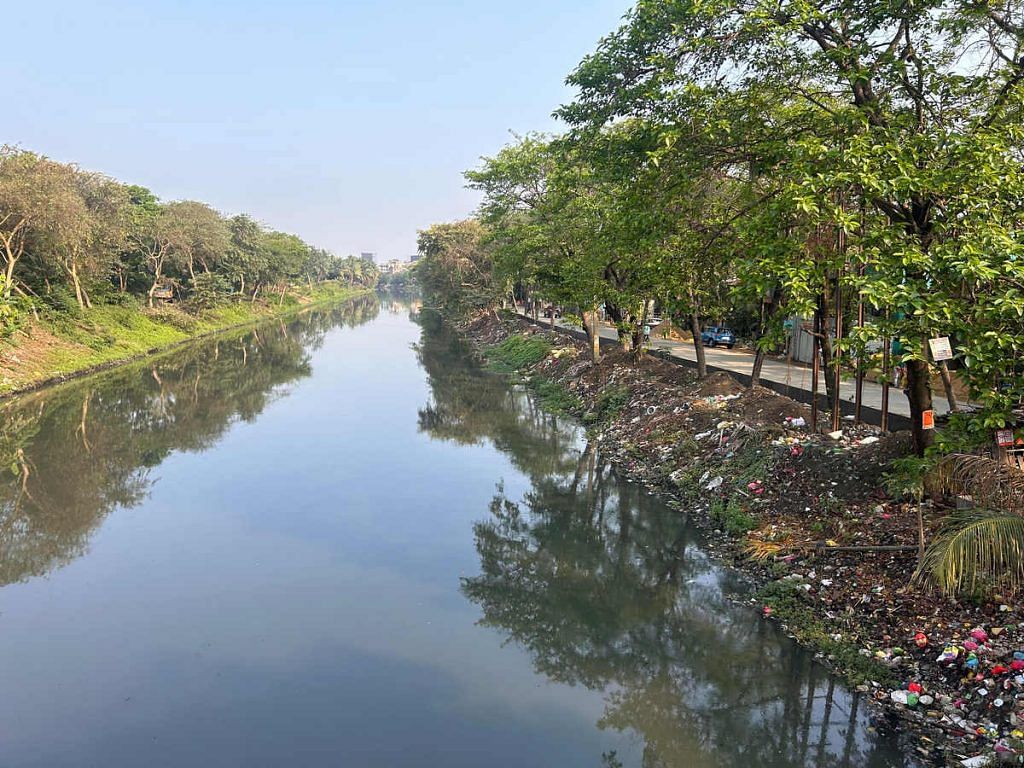
Designed as a planned urban township, it’s home to imposing flyovers, palm-lined roads, stylish residential complexes, glass-fronted office high-rises, and upmarket malls. But this image of modernity and order is marred not just by dirty markets but by the environmental challenges posed by the Kestopur canal. Skirting the city’s periphery, the canal has become a source of concern for both the local body and residents.
Inadequate dredging, coupled with unauthorised settlements along its banks where open defecation is common, has transformed the canal into a breeding ground for mosquitoes and a repository for waste, emitting a dreadful stench that permeates the air.
“It’s so dirty, it’s an open drain now,” said a resident of AJ block next to the Kestopur canal.
For Ujjwal Biswas, carrying his groceries back from the dirty market to his clean colony, the issue of dirt seems to have lost its urgency.
“Everyone is going about their daily business. Who cares about the piling garbage on the roadside anymore?” he said. “It’s only if there’s dirt in front of our homes that we sit up.”
(Edited by Asavari Singh)



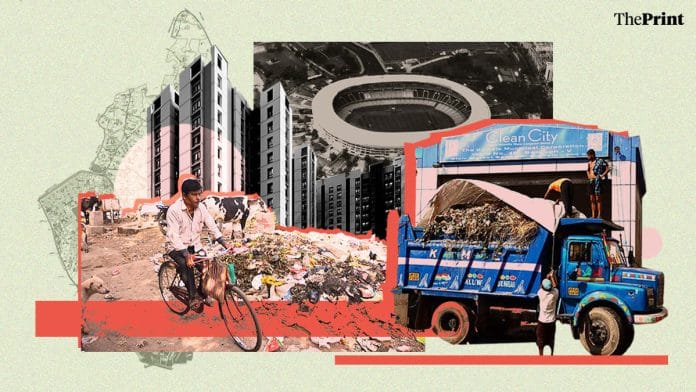



The survey is politically biased. I have been to Kalyani, Bidhannagar, Durgapur, New Town, Vizag, Indore, Mumbai , Bangalore and New Delhi.. I can say that personally that
1. Gurgaon is more dirty and marred with construction work without any planning. Last week I visited Gurgaon and there was no access to Microsoft / Deloitte and Google offices due to unplanned construction work.. There was a time Gurgaon was clean and planned but not today . Same holds for Bangalore.
2. Indore is clean but the same level of cleanliness is available at Kalyani and Bidhannagar.. The persons questioning this assessment should visit both the towns / cities and then pass judgement. The cleaniless of the towns is however super passed by New Town which being a newer township is better planned and clean.
3. Vizag was the only place which I really find clean and highly recommended.
4. For mumbai and delhi they are overhyped as per cleanliness is concerned. Being metro they are at par with all other metros.